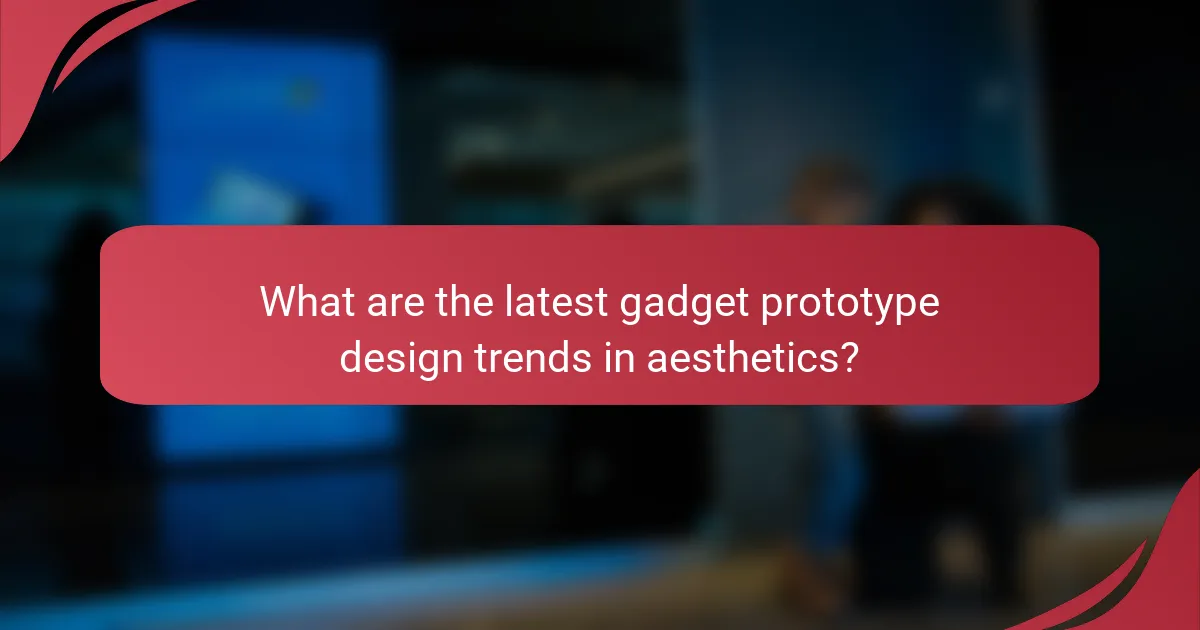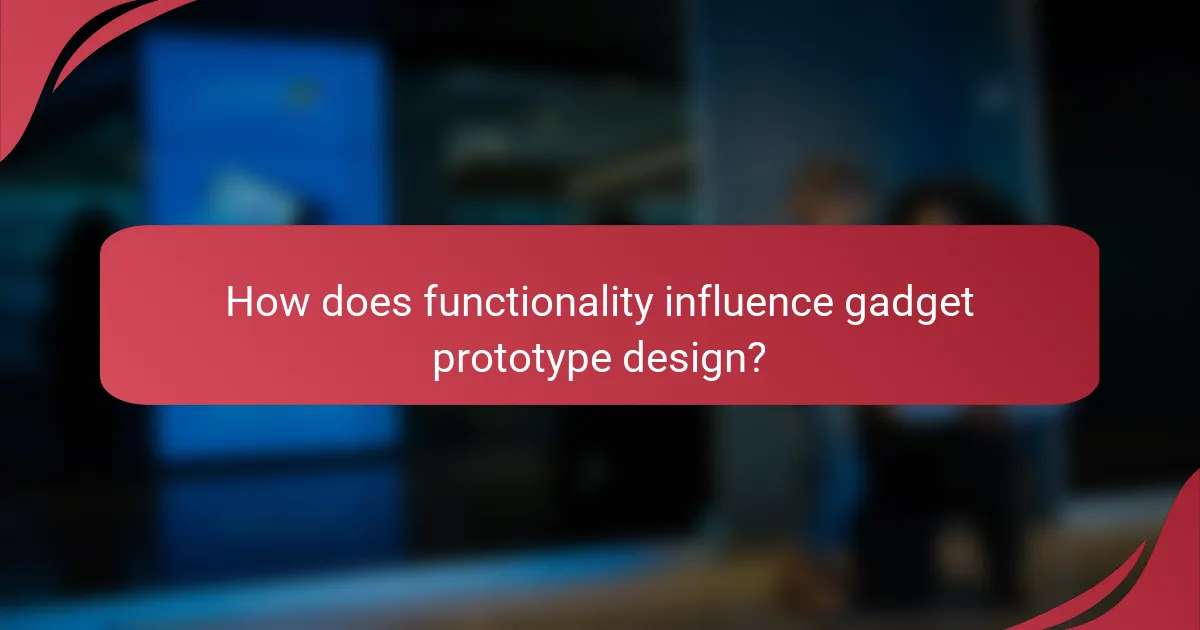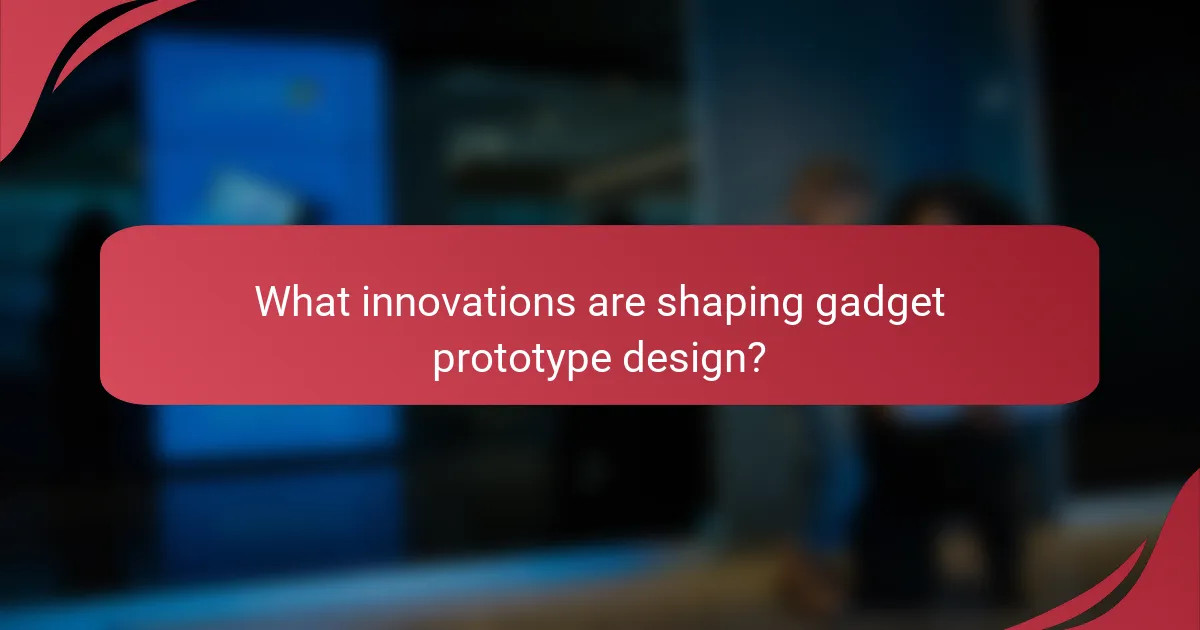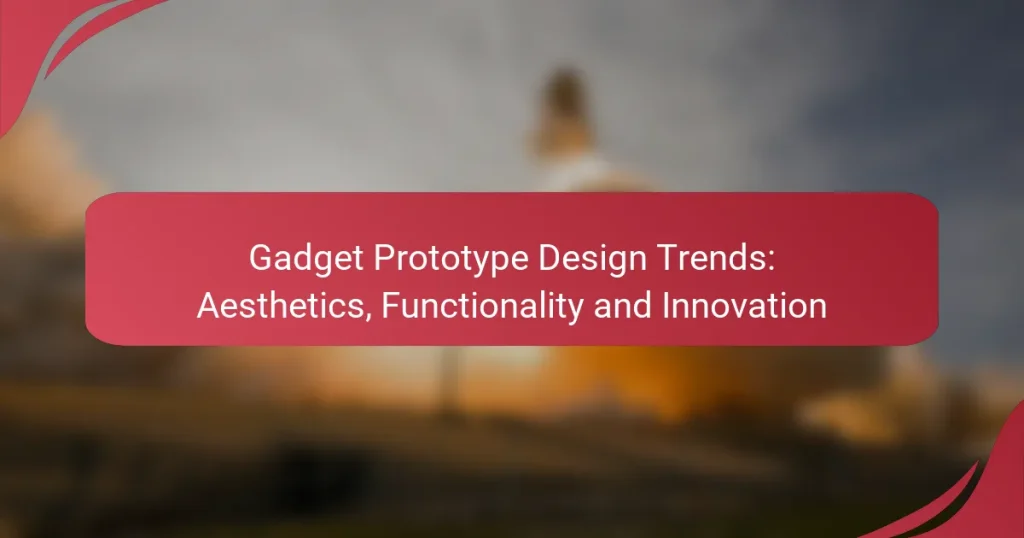The landscape of gadget prototype design is evolving, with a strong emphasis on aesthetics, functionality, and innovation. Current trends highlight the importance of simplicity and sustainability, as designers integrate eco-friendly materials and minimalist principles to enhance user comfort. Additionally, advancements in technologies such as 3D printing and artificial intelligence are revolutionizing the design process, enabling the creation of more effective and visually appealing gadgets.

What are the latest gadget prototype design trends in aesthetics?
The latest trends in gadget prototype design aesthetics focus on simplicity, sustainability, and user comfort. Designers are increasingly prioritizing minimalist principles, eco-friendly materials, and innovative technology integration to create visually appealing and functional products.
Minimalist design principles
Minimalist design emphasizes simplicity and functionality, stripping away unnecessary elements to focus on core features. This approach often results in sleek, clean lines and a clutter-free appearance, making gadgets more user-friendly. For example, many modern smartphones feature minimal bezels and intuitive interfaces that enhance usability.
When adopting minimalist principles, consider the balance between aesthetics and functionality. Aim for a design that feels open and inviting while still providing all essential features without overwhelming the user.
Use of sustainable materials
Incorporating sustainable materials into gadget prototypes is becoming increasingly important as consumers prioritize eco-friendliness. Designers are exploring options like recycled plastics, biodegradable components, and sustainably sourced metals. This shift not only reduces environmental impact but also appeals to a growing market of eco-conscious consumers.
When selecting materials, consider durability and lifecycle. Choose options that not only minimize environmental harm but also ensure longevity and performance, which can enhance the overall value of the product.
Bold color palettes
Bold color palettes are gaining traction in gadget design, moving away from traditional neutral tones to vibrant hues that express personality and creativity. Bright colors can make products stand out in a crowded market, attracting attention and encouraging user engagement. For instance, tech accessories like headphones and smartwatches are now available in a variety of eye-catching colors.
When implementing bold colors, think about your target audience and brand identity. Ensure that the colors resonate with potential users while maintaining a cohesive look across the product line.
Ergonomic shapes
Ergonomic shapes are essential in gadget design, as they enhance user comfort and usability. Products that fit naturally in the hand or adapt to the user’s body can significantly improve the overall experience. For example, curved designs in handheld devices can reduce strain during prolonged use.
To achieve ergonomic shapes, conduct user testing to gather feedback on comfort and usability. This iterative process can help refine designs to better meet user needs and preferences.
Integration of smart technology
The integration of smart technology into gadget prototypes is a key trend that enhances functionality and user interaction. Features like voice control, connectivity with other devices, and AI-driven functionalities are becoming standard in many products. This trend allows for a more seamless user experience, making gadgets more intuitive and responsive.
When incorporating smart technology, prioritize user privacy and data security. Ensure that any connected features comply with relevant regulations and provide users with control over their data to build trust and enhance user satisfaction.

How does functionality influence gadget prototype design?
Functionality is a critical factor in gadget prototype design, as it directly impacts user experience and product success. Designers must prioritize practical features that enhance usability while ensuring the gadget meets its intended purpose effectively.
User-centered design approach
A user-centered design approach focuses on understanding the needs and preferences of the end-users throughout the development process. This involves conducting user research, creating personas, and gathering feedback to ensure the gadget aligns with user expectations.
Incorporating user feedback early can lead to prototypes that are more intuitive and appealing. For instance, usability testing can reveal pain points that designers can address before finalizing the product.
Modular components for versatility
Modular components allow for greater versatility in gadget design, enabling users to customize their devices according to their specific needs. This approach can enhance functionality by allowing users to add or remove features as required.
For example, a smartphone with interchangeable camera modules can cater to photography enthusiasts while maintaining a slim profile for everyday users. This adaptability can significantly increase the gadget’s appeal across different market segments.
Enhanced user interfaces
Enhanced user interfaces (UIs) are essential for improving functionality and user satisfaction. A well-designed UI should be intuitive, responsive, and visually appealing, facilitating seamless interaction with the gadget.
Incorporating touchscreens, voice recognition, or gesture controls can elevate the user experience. For instance, smart home devices that utilize voice commands allow users to operate them hands-free, making them more accessible and convenient.
Durability and longevity
Durability and longevity are vital considerations in gadget prototype design, as they influence the product’s lifespan and user satisfaction. A durable gadget can withstand daily wear and tear, reducing the need for frequent replacements.
Designers should select materials that are robust yet lightweight, such as polycarbonate or aluminum. Additionally, adhering to industry standards for water and dust resistance can enhance the gadget’s reliability in various environments.

What innovations are shaping gadget prototype design?
Innovations like 3D printing, augmented reality, and artificial intelligence are significantly influencing gadget prototype design. These technologies enhance aesthetics, improve functionality, and foster innovation, allowing designers to create more effective and appealing products.
3D printing technology
3D printing technology revolutionizes gadget prototype design by enabling rapid prototyping and customization. Designers can quickly create physical models from digital files, allowing for immediate testing and iteration. This technology reduces production costs and time, making it feasible to experiment with complex geometries that traditional manufacturing methods cannot achieve.
When using 3D printing, consider material selection carefully. Common materials include plastics like PLA and ABS, which are suitable for functional prototypes, while more advanced options like nylon or resin offer enhanced durability and detail. Aim for a balance between cost and quality to optimize your prototype’s effectiveness.
Augmented reality in prototyping
Augmented reality (AR) enhances the prototyping process by allowing designers to visualize their concepts in real-world settings. AR tools can overlay digital designs onto physical environments, enabling stakeholders to interact with prototypes before they are built. This immediate feedback can lead to better design decisions and improved user experience.
To effectively implement AR in your design process, use software that supports AR visualization. Tools like Adobe Aero or Unity can help create interactive experiences. Ensure that your team is trained to utilize these tools effectively, as proper integration can significantly streamline the prototyping phase.
Artificial intelligence for design optimization
Artificial intelligence (AI) plays a crucial role in optimizing gadget prototype design by analyzing data and suggesting improvements. AI algorithms can evaluate design parameters, predict performance outcomes, and identify potential issues early in the development process. This capability allows for more informed decision-making and can lead to innovative solutions that enhance functionality.
Incorporating AI into your design workflow requires access to relevant data and the right tools. Consider using platforms that offer AI-driven design assistance, such as Autodesk’s Fusion 360 or Siemens’ NX. Be mindful of the learning curve associated with these technologies and invest time in training to maximize their benefits.

What are the key considerations for selecting materials in gadget prototypes?
When selecting materials for gadget prototypes, key considerations include weight, cost, and environmental impact. These factors significantly influence the prototype’s functionality, user experience, and market viability.
Weight and portability
Weight and portability are crucial in gadget design, especially for handheld devices. Lighter materials, such as plastics or aluminum, enhance user comfort and ease of transport. Aim for materials that maintain structural integrity while minimizing weight, typically targeting a weight range that feels manageable for the intended user base.
Consider the balance between durability and portability. For example, while carbon fiber is lightweight, it can be more expensive and less accessible than traditional plastics. Evaluate the target audience’s needs to determine the best material choice.
Cost-effectiveness
Cost-effectiveness is essential in prototype development, as it directly impacts production budgets and pricing strategies. Selecting materials that are affordable yet functional can help keep overall costs low. For instance, using common thermoplastics can reduce expenses compared to specialized composites.
When assessing cost, factor in not just the material price but also manufacturing processes and potential waste. Opt for materials that can be easily sourced and processed within budget constraints, ideally under a specific cost per unit, such as $5 to $15 for basic components.
Environmental impact
The environmental impact of materials is increasingly important in gadget design. Eco-friendly materials, such as biodegradable plastics or recycled metals, can enhance a product’s appeal and align with consumer values. Consider certifications like FSC for wood or ISO 14001 for environmental management when selecting materials.
Evaluate the entire lifecycle of materials, from sourcing to disposal. Aim for options that minimize carbon footprint and waste, such as using local suppliers to reduce transportation emissions. This approach not only benefits the environment but can also resonate with eco-conscious consumers, potentially boosting market success.

How do trends in gadget design vary across different markets?
Trends in gadget design differ significantly across markets due to cultural preferences, technological advancements, and consumer needs. Understanding these variations can help designers create products that resonate with specific audiences.
Consumer electronics in North America
In North America, consumer electronics emphasize sleek aesthetics and user-friendly interfaces. Popular trends include minimalistic designs with high functionality, such as smartphones and laptops that prioritize portability and performance.
Manufacturers often focus on integrating advanced features like voice assistants and high-resolution displays. Brands like Apple and Samsung lead the market by consistently innovating while maintaining a strong emphasis on design quality and user experience.
Wearable technology in Europe
European wearable technology trends highlight health and sustainability, with a growing interest in fitness trackers and smartwatches that monitor health metrics. Devices often feature eco-friendly materials and designs that appeal to environmentally conscious consumers.
Brands like Garmin and Fitbit are popular, offering products that combine functionality with style. Consumers in Europe tend to prefer wearables that seamlessly integrate into their daily lives, emphasizing practicality alongside aesthetics.
Smart home devices in Asia
In Asia, smart home devices are rapidly evolving, with a strong focus on connectivity and automation. Trends include the integration of artificial intelligence and IoT (Internet of Things) to create smart ecosystems that enhance convenience and security.
Companies like Xiaomi and Huawei dominate the market, offering a wide range of affordable yet innovative smart home products. Consumers often seek devices that can be easily controlled via smartphones, reflecting a preference for technology that simplifies everyday tasks.


